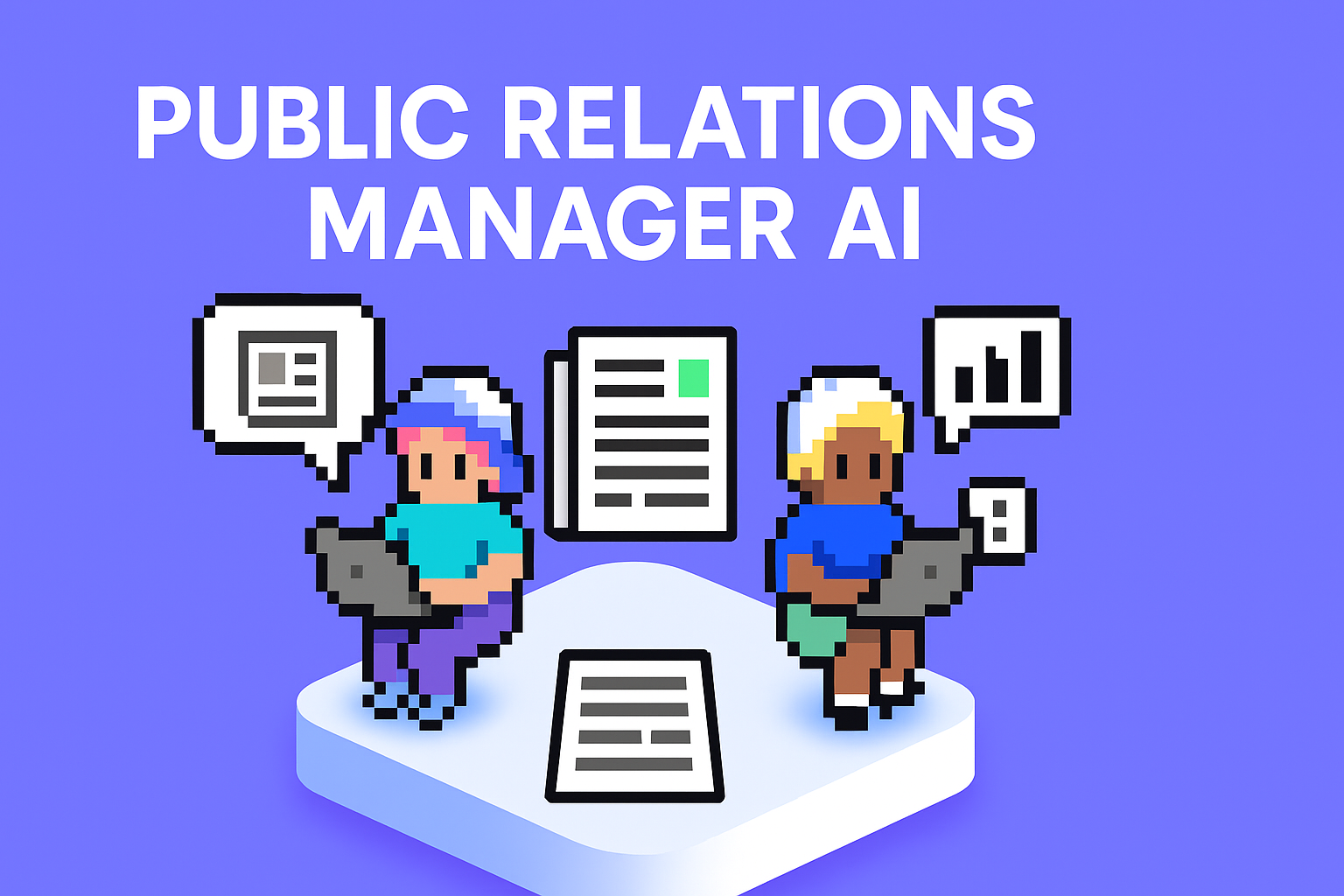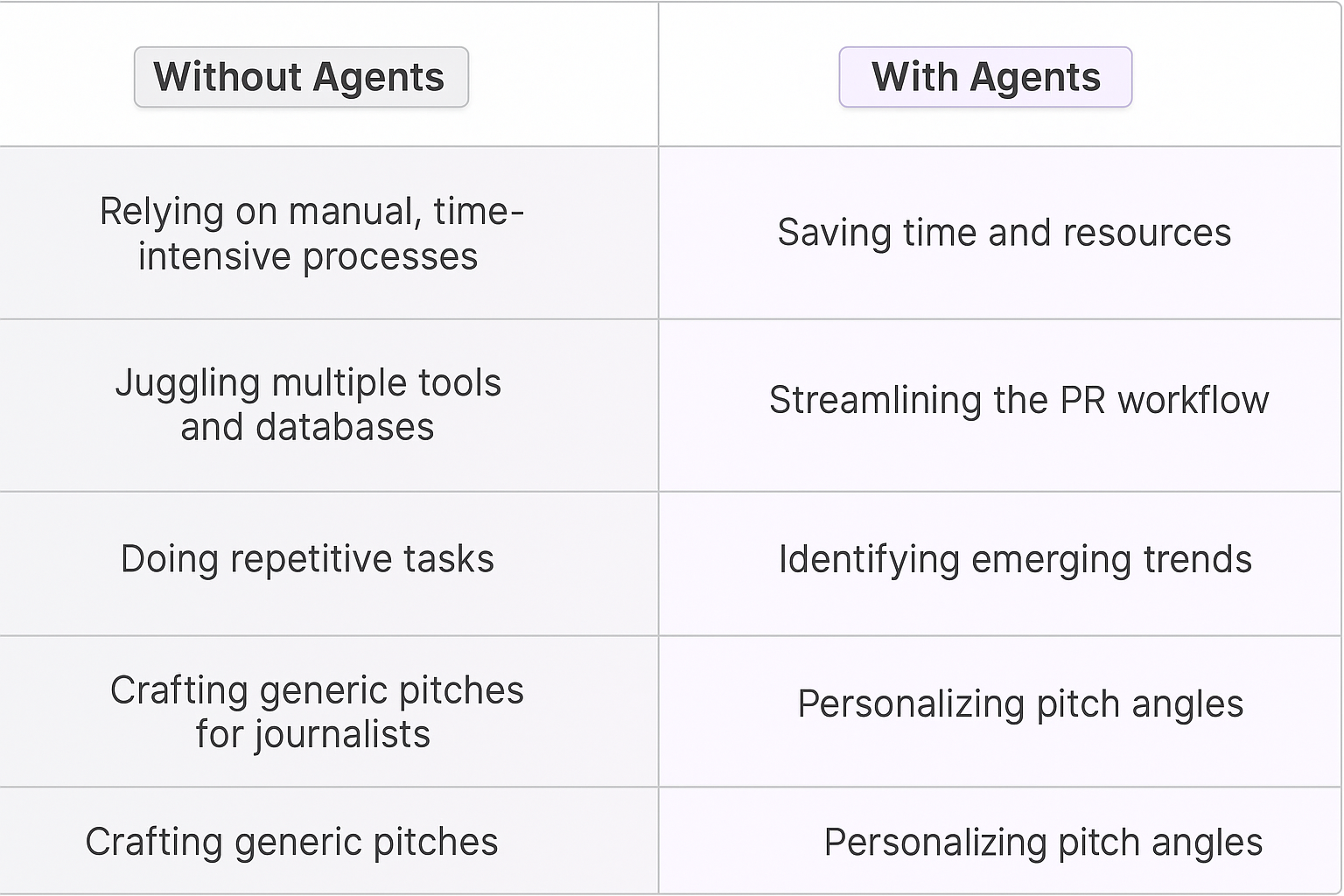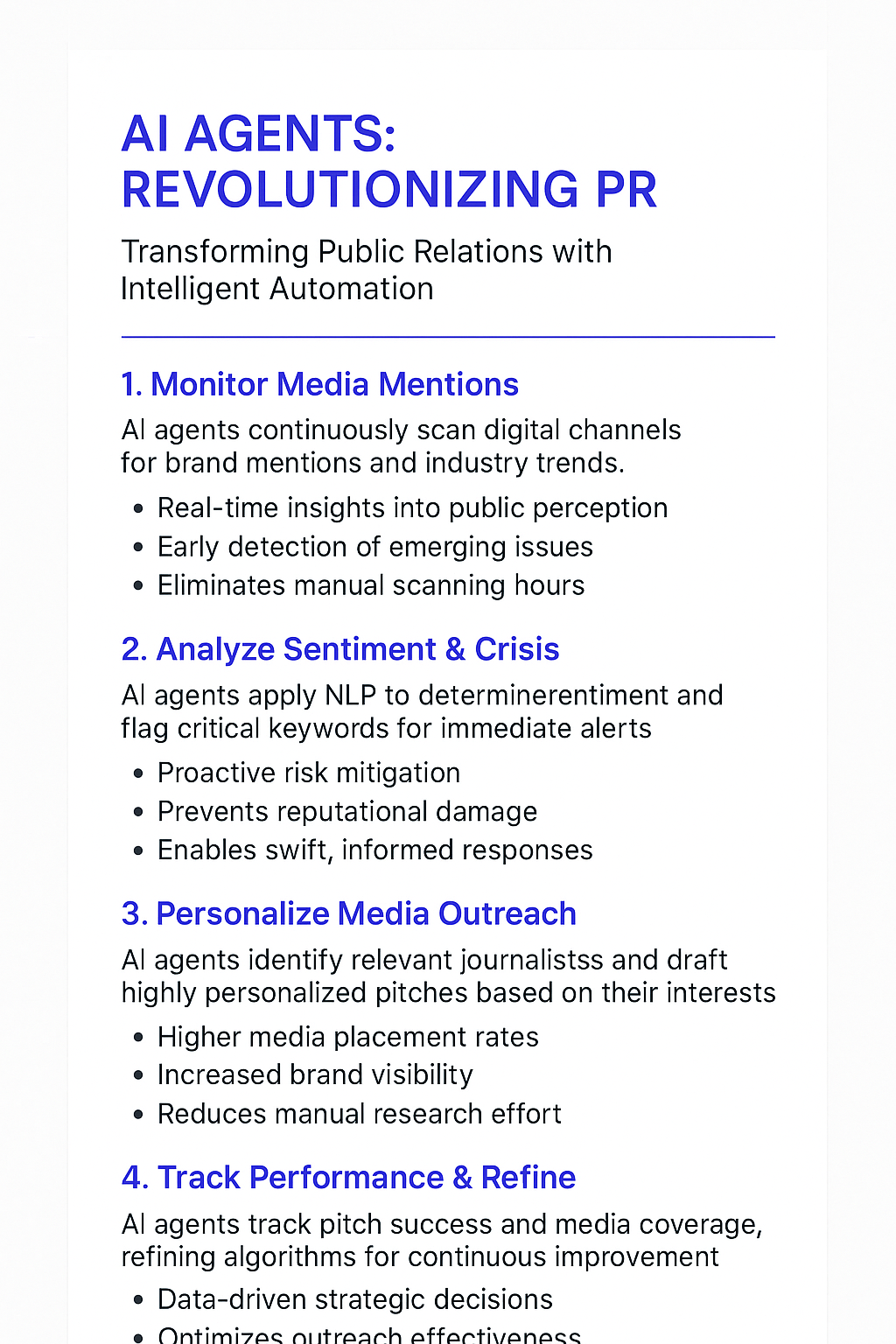
Public Relations Manager represents a new breed of AI-powered tools that work alongside [PR professionals](https://relevanceai.com/agent-templates-roles/public-relations-manager-ai-agents-1) to enhance [media outreach](https://relevanceai.com/agent-templates-tasks/email-campaign-generation), monitor brand sentiment, and scale communications efforts. The technology combines natural language processing, machine learning, and media analytics to transform how organizations manage their public image and stakeholder relationships.

Traditional PR teams relied heavily on manual processes that consumed massive amounts of time and resources. They'd spend hours scanning media outlets, maintaining spreadsheets of journalist contacts, and crafting individual pitches. The workflow typically involved multiple team members juggling various tools like [Google Alerts](https://relevanceai.com/agent-templates-software/google), media databases, email templates, and coverage tracking systems. PR professionals often found themselves doing repetitive tasks instead of building meaningful relationships with journalists and crafting compelling narratives.
The integration of AI agents into PR operations creates a fundamental shift in how teams operate. These digital teammates excel at pattern recognition across vast amounts of media data, identifying emerging trends before they peak. They can analyze journalist writing patterns and preferences, suggesting personalized pitch angles that resonate with specific reporters.
[Media monitoring](https://relevanceai.com/agent-templates-tasks/brand-monitoring-ai-agents) becomes exponentially more sophisticated - AI agents can detect subtle shifts in sentiment and flag potential PR issues before they escalate into crises. They're particularly effective at identifying relevant journalists based on their previous coverage, writing style, and engagement patterns.
The real game-changer is in content creation and distribution. AI agents can draft press releases and media pitches that maintain brand voice while adapting to each journalist's interests. They learn from successful pitches and continuously refine their approach based on response rates and coverage outcomes.
For measurement and analytics, these digital teammates provide granular insights about campaign performance, media sentiment, and share of voice - connecting PR efforts directly to business outcomes. This data-driven approach helps PR teams prove ROI and make strategic decisions about resource allocation.
Most importantly, AI agents handle the time-consuming tasks that previously kept PR professionals from doing their best work. This allows teams to focus on strategy, relationship building, and creative storytelling - the human elements that truly drive PR success.
PR is fundamentally about building and maintaining relationships at scale. Digital teammates in PR create powerful feedback loops by continuously learning from media interactions, journalist preferences, and campaign outcomes. They're particularly effective at identifying patterns in successful media placements and replicating those winning approaches.
The most interesting aspect is how PR AI agents can process vast amounts of media coverage and social sentiment in real-time, something that traditionally required entire teams of analysts. This creates a new kind of PR professional - one who can make strategic decisions based on comprehensive data while focusing their human creativity on relationship building and narrative crafting.
What makes this truly powerful is the network effect: each successful media placement, each journalist interaction, and each crisis managed becomes training data that improves the system's effectiveness. This compounds over time, creating an increasingly sophisticated PR operation that can operate at previously impossible scales.
Start small with focused use cases like media monitoring and basic press release drafting. The key is to build trust in the system gradually while maintaining human oversight on sensitive communications. As confidence grows, expand into more complex tasks like crisis communication planning and proactive media outreach.
The most successful implementations pair AI capabilities with human PR professionals' expertise, creating a hybrid approach that maximizes both efficiency and authenticity. This allows PR teams to scale their impact while maintaining the personal touch essential to effective public relations.

The versatility of AI agents in Public Relations Management creates fascinating opportunities across multiple sectors. [PR managers](https://relevanceai.com/agent-templates-roles/marketing-communications-manager-ai-agents-1) at Fortune 500 companies deploy digital teammates to [analyze media sentiment](https://relevanceai.com/agent-templates-tasks/customer-voice-analysis) at scale, while boutique agencies use them to craft personalized pitches that resonate with specific journalists. The real magic happens when these AI agents start connecting dots that humans might miss.
Take the healthcare sector, where PR teams handle sensitive communications around clinical trials and regulatory approvals. AI agents can process thousands of past media interactions, learning which approaches worked best for different types of announcements. They're particularly effective at identifying subtle patterns in journalist responses and adapting pitch strategies accordingly.
In the tech industry, PR managers are using AI agents to navigate the complexities of product launches and funding announcements. These digital teammates monitor competitor communications, track industry trends, and help maintain consistent messaging across dozens of channels simultaneously. The result? PR teams can focus on building genuine relationships while their AI counterparts handle the data-heavy lifting.
The most successful implementations aren't about replacing human PR professionals - they're about augmenting their capabilities with AI-powered insights and execution support. This hybrid approach is becoming the new standard for high-performing PR operations.
Managing public relations for A-list celebrities requires constant vigilance across social media, news outlets, and emerging stories. PR teams often struggle to stay ahead of narratives that can spiral out of control within minutes. This is where PR Manager AI agents create transformative value.
Take a major talent agency representing 50+ high-profile actors and musicians. Their PR Manager AI agent monitors millions of social media posts, news articles, and online discussions in real-time, identifying potential PR issues before they become crises. When the AI detects concerning signals - like an emerging negative narrative or unauthorized photo leak - it immediately alerts the human PR team with detailed context and suggested response strategies.
The AI doesn't just identify problems - it actively shapes positive narratives by analyzing which types of stories and content resonate most with each celebrity's audience. For a music artist preparing to launch a new album, the AI might notice that behind-the-scenes studio content performs 3x better than polished promotional shots. This intelligence helps PR teams craft more authentic, engaging campaigns.
What's fascinating is how the AI learns each celebrity's unique voice and brand identity. When drafting [social media responses](https://relevanceai.com/agent-templates-tasks/social-media-management-ai-agents) or [press statements](https://relevanceai.com/agent-templates-tasks/content-creation-ai-agents), it maintains consistent messaging while adapting tone - from Taylor Swift's warm authenticity to Ryan Reynolds' witty sarcasm. This allows PR teams to scale their efforts while preserving the personal touch that fans expect.
The results speak for themselves: Entertainment PR firms using AI agents report 60% faster response times to emerging issues and a 40% increase in positive media coverage. But perhaps most importantly, it gives human PR professionals the bandwidth to focus on high-level strategy and relationship building - the parts of PR that truly require a human touch.
The complexity of healthcare PR keeps me up at night. Running communications for a major hospital system means juggling patient privacy, medical accuracy, regulatory compliance, and crisis management - often simultaneously. PR Manager AI agents are becoming the secret weapon for healthcare communicators tackling these challenges.
A fascinating case study comes from a network of 12 hospitals across the Midwest. Their PR team deployed an AI agent that [monitors patient feedback](https://relevanceai.com/agent-templates-tasks/customer-feedback-analysis-ai-agents), local health trends, and media coverage across their entire system. When a flu outbreak hit three counties simultaneously, the AI analyzed infection rate data, hospital capacity metrics, and social sentiment to help [craft targeted communications](https://relevanceai.com/agent-templates-tasks/email-response-generation) for each community.
The AI's pattern recognition capabilities proved invaluable during sensitive situations. For instance, when social media posts suggested a potential HIPAA violation at one facility, the AI flagged the issue within minutes and provided the PR team with relevant policy documentation and pre-approved response templates. This rapid response system helped contain the situation before it reached mainstream media.
What's particularly clever is how the AI adapts messaging across different stakeholder groups. It understands that communications to medical staff require technical precision, while patient-facing updates need clarity and empathy. During a recent hospital expansion announcement, the AI helped generate tailored communications for employees, local residents, and media outlets - each hitting the right notes for their audience.
The metrics tell an interesting story: Healthcare systems using PR Manager AI agents see a 45% reduction in response time to media inquiries and a 70% improvement in consistent messaging across departments. But the real game-changer is how it empowers PR teams to shift from reactive to proactive communication strategies, building stronger community relationships in the process.

PR Manager AI agents need sophisticated natural language processing to understand brand voice, context, and nuance - something that current models still struggle with. The agent must parse complex media landscapes, understand sentiment analysis, and maintain consistent messaging across multiple channels. Building these capabilities requires significant training data from past PR campaigns, crisis communications, and media interactions.
Maintaining authentic brand personality while automating PR functions presents a delicate balance. The AI needs to capture subtle tones - whether playful, professional, or empathetic - without falling into robotic responses. Organizations must invest time in training the model on their unique communication style and regularly audit outputs to ensure brand consistency.
While AI can handle routine PR tasks effectively, high-stakes crisis situations demand human judgment. The agent may miss crucial cultural contexts or fail to read between the lines in sensitive scenarios. Organizations need clear escalation protocols for when human PR professionals must take the lead, especially during reputation-threatening events.
Building and maintaining relationships with journalists and [influencers](https://relevanceai.com/agent-templates-roles/community-marketing-manager-ai-agents-1) requires emotional intelligence and personal connection - areas where AI still falls short. The technology works best as a support tool for relationship management rather than replacing human interaction entirely. PR teams should carefully consider which touchpoints remain human-led versus AI-assisted.
Transparency about AI usage in PR communications raises important ethical questions. Organizations must decide whether to disclose when media interactions are AI-driven and establish guidelines for maintaining authenticity. There's also the challenge of ensuring the AI doesn't inadvertently spread misinformation or cross ethical boundaries in pursuit of positive coverage.
PR Manager AI agents handle sensitive corporate information and media contact details, requiring robust security measures and compliance with data protection regulations. Organizations need clear protocols for data handling, storage limits, and access controls to protect both company and stakeholder information.
The most successful [crisis communications](https://relevanceai.com/agent-templates-tasks/incident-response-automation-ai-agents) strategies combine AI efficiency with human oversight, ensuring rapid response while maintaining authenticity and cultural sensitivity.
The integration of AI agents in PR management marks a significant shift in how organizations approach public relations. While the technology excels at [data analysis](https://relevanceai.com/agent-templates-tasks/business-intelligence-ai-agents), [content generation](https://relevanceai.com/agent-templates-tasks/landing-page-copy-generator), and process automation, its true value lies in augmenting human PR professionals rather than replacing them. The most successful implementations create a symbiotic relationship where AI handles routine tasks and data processing, freeing PR teams to focus on strategy and relationship building. As these systems continue to evolve, we'll likely see even more sophisticated applications that further transform the PR landscape while maintaining the essential human element that drives successful public relations.